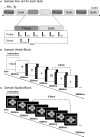The complex interaction between anxiety and cognition: insight from spatial and verbal working memory
- PMID: 23542914
- PMCID: PMC3610083
- DOI: 10.3389/fnhum.2013.00093
The complex interaction between anxiety and cognition: insight from spatial and verbal working memory
Abstract
Anxiety can be distracting, disruptive, and incapacitating. Despite problems with empirical replication of this phenomenon, one fruitful avenue of study has emerged from working memory (WM) experiments where a translational method of anxiety induction (risk of shock) has been shown to disrupt spatial and verbal WM performance. Performance declines when resources (e.g., spatial attention, executive function) devoted to goal-directed behaviors are consumed by anxiety. Importantly, it has been shown that anxiety-related impairments in verbal WM depend on task difficulty, suggesting that cognitive load may be an important consideration in the interaction between anxiety and cognition. Here we use both spatial and verbal WM paradigms to probe the effect of cognitive load on anxiety-induced WM impairment across task modality. Subjects performed a series of spatial and verbal n-back tasks of increasing difficulty (1, 2, and 3-back) while they were safe or at risk for shock. Startle reflex was used to probe anxiety. Results demonstrate that induced-anxiety differentially impacts verbal and spatial WM, such that low and medium-load verbal WM is more susceptible to anxiety-related disruption relative to high-load, and spatial WM is disrupted regardless of task difficulty. Anxiety impacts both verbal and spatial processes, as described by correlations between anxiety and performance impairment, albeit the effect on spatial WM is consistent across load. Demanding WM tasks may exert top-down control over higher-order cortical resources engaged by anxious apprehension, however high-load spatial WM may continue to experience additional competition from anxiety-related changes in spatial attention, resulting in impaired performance. By describing this disruption across task modalities, these findings inform current theories of emotion-cognition interactions and may facilitate development of clinical interventions that seek to target cognitive impairments associated with anxiety.
Keywords: anxiety; cognition; electromyography; performance; startle; working memory.
Figures



Similar articles
-
Induced-anxiety differentially disrupts working memory in generalized anxiety disorder.BMC Psychiatry. 2016 Mar 15;16:62. doi: 10.1186/s12888-016-0748-2. BMC Psychiatry. 2016. PMID: 26976146 Free PMC article.
-
Investigating the influence of working memory capacity when driving behavior is combined with cognitive load: An LCT study of young novice drivers.Accid Anal Prev. 2014 Jan;62:377-87. doi: 10.1016/j.aap.2013.06.032. Epub 2013 Jul 4. Accid Anal Prev. 2014. PMID: 23915472
-
Interaction of induced anxiety and verbal working memory: influence of trait anxiety.Learn Mem. 2017 Aug 16;24(9):407-413. doi: 10.1101/lm.044123.116. Print 2017 Sep. Learn Mem. 2017. PMID: 28814466 Free PMC article.
-
Cognitive deficits in bipolar disorders: Implications for emotion.Clin Psychol Rev. 2018 Feb;59:126-136. doi: 10.1016/j.cpr.2017.11.006. Epub 2017 Nov 21. Clin Psychol Rev. 2018. PMID: 29195773 Free PMC article. Review.
-
A working memory "theory of relativity": elasticity in temporal, spatial, and modality dimensions conserves item capacity in radial maze, verbal tasks, and other cognition.Brain Res Bull. 1999 Mar 15;48(5):475-89. doi: 10.1016/s0361-9230(99)00026-x. Brain Res Bull. 1999. PMID: 10372508 Review.
Cited by
-
Dietary Patterns and Their Association with Anxiety Symptoms among Older Adults: The ATTICA Study.Nutrients. 2019 May 31;11(6):1250. doi: 10.3390/nu11061250. Nutrients. 2019. PMID: 31159322 Free PMC article.
-
Emergency medical services responders' perceptions of the effect of stress and anxiety on patient safety in the out-of-hospital emergency care of children: a qualitative study.BMJ Open. 2017 Feb 28;7(2):e014057. doi: 10.1136/bmjopen-2016-014057. BMJ Open. 2017. PMID: 28246139 Free PMC article.
-
The impact of threat of shock-induced anxiety on the neural substrates of memory encoding and retrieval.Soc Cogn Affect Neurosci. 2019 Oct 1;14(10):1087-1096. doi: 10.1093/scan/nsz080. Soc Cogn Affect Neurosci. 2019. PMID: 31680142 Free PMC article.
-
Larger increase in trait negative affect is associated with greater future cognitive decline and vice versa across 23 years.Depress Anxiety. 2021 Feb;38(2):146-160. doi: 10.1002/da.23093. Epub 2020 Aug 25. Depress Anxiety. 2021. PMID: 32840954 Free PMC article.
-
The role of dlPFC laterality in the expression and regulation of anxiety.Neuropharmacology. 2023 Feb 15;224:109355. doi: 10.1016/j.neuropharm.2022.109355. Epub 2022 Nov 26. Neuropharmacology. 2023. PMID: 36442650 Free PMC article. Review.
References
-
- Bandura A. (1988). Self-efficacy conception of anxiety. Anxiety Res. 1, 77–98
-
- Bonanno G. A., Keltner D., Holen A., Horowitz M. J. (1995). When avoiding unpleasant emotions might not be such a bad thing: verbal-autonomic response dissociation and midlife conjugal bereavement. J. Pers. Soc. Psychol. 69, 975 - PubMed
LinkOut - more resources
Full Text Sources
Other Literature Sources

